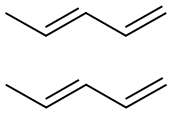PROTOPORPHYRINATO ZINC
Synonym(s):Zinc (II) Protoporphyrin IX - CAS 15442-64-5 - Calbiochem;ZnPP-9
- CAS NO.:15442-64-5
- Empirical Formula: C34H31N4O4Zn-
- Molecular Weight: 625.03
- MDL number: MFCD00011612
- EINECS: 239-455-7
- SAFETY DATA SHEET (SDS)
- Update Date: 2024-12-18 14:15:30

What is PROTOPORPHYRINATO ZINC?
The Uses of PROTOPORPHYRINATO ZINC
Zinc Protoporphyrin is a metabolite formed during biosynthesis and is used to evaluate iron nutrition and metabolism.
What are the applications of Application
Zinc Protoporphyrin-9 is a potent, selective inhibitor of heme oxygenase, GCS, NOS1, NOS2, and NOS3.
General Description
A potent and selective inhibitor of heme oxygenase, the enzyme which generates carbon monoxide (CO) and biliverdin. Inhibits soluble guanylyl cyclase and produces a time- and concentration-dependent inactivation of all three isoforms of nitric oxide synthase (IC50 = 800 nM, 4 μM, and 5 μM for nNOS, iNOS, and eNOS, respectively). Inhibits relaxation induced by acetylcholine, ANP, and VIP in isolated rat aorta. Blocks interleukin-1 and prevents induction of long-term potentiation. Also useful as an indicator of iron-deficient erythropoiesis. Does not cross the blood-brain barrier.
Biological Activity
Inhibitor of heme oxygenase, which generates the putative neurotransmitter CO.
Biochem/physiol Actions
Primary Targetheme oxygenase
Properties of PROTOPORPHYRINATO ZINC
| RTECS | ZG9210300 |
| storage temp. | Inert atmosphere,2-8°C |
| solubility | DMSO : 50 mg/mL (79.87 mM; Need ultrasonic)H2O : < 0.1 mg/mL (insoluble) |
| form | Crystalline |
| color | Dark red to purple |
| Water Solubility | Insoluble in water. Soluble in ethanol, and DMSO, pyridine, or dimethyl formamide. |
| Stability: | Hygroscopic |
| EPA Substance Registry System | Zincate(2-), [7,12-diethenyl-3,8,13,17-tetramethyl-21H,23H-porphine-2,18-dipropanoato(4-)-.kappa.N21,.kappa.N22,.kappa.N23,.kappa.N24]-, dihydrogen, (SP-4-2)- (15442-64-5) |
Safety information for PROTOPORPHYRINATO ZINC
| Signal word | Warning |
| Pictogram(s) |
 Exclamation Mark Irritant GHS07 |
| GHS Hazard Statements |
H302:Acute toxicity,oral H315:Skin corrosion/irritation H319:Serious eye damage/eye irritation H335:Specific target organ toxicity, single exposure;Respiratory tract irritation |
| Precautionary Statement Codes |
P261:Avoid breathing dust/fume/gas/mist/vapours/spray. P280:Wear protective gloves/protective clothing/eye protection/face protection. P301+P312:IF SWALLOWED: call a POISON CENTER or doctor/physician IF you feel unwell. P302+P352:IF ON SKIN: wash with plenty of soap and water. P305+P351+P338:IF IN EYES: Rinse cautiously with water for several minutes. Remove contact lenses, if present and easy to do. Continuerinsing. |
Computed Descriptors for PROTOPORPHYRINATO ZINC
New Products
(S)-3-Aminobutanenitrile hydrochloride 4-Methylphenylacetic acid N-Boc-D-alaninol N-BOC-D/L-ALANINOL Tert-butyl bis(2-chloroethyl)carbamate 3-Morpholino-1-(4-nitrophenyl)-5,6-dihydropyridin- 2(1H)-one Furan-2,5-Dicarboxylic Acid Tropic acid 1-Bromo-3,5-Di-Tert-Butylbenzene S-2-CHLORO PROPIONIC ACID ETHYL ISOCYANOACETATE 2-Bromo-1,3-Bis(Dimethylamino)Trimethinium Hexafluorophosphate 4-IODO BENZOIC ACID 3-NITRO-2-METHYL ANILINE 1-(2,4-DICHLOROPHENYL) ETHANAMINE (2-Hydroxyphenyl)acetonitrile 4-Bromopyrazole 2-(Cyanocyclohexyl)acetic acid 4-methoxy-3,5-dinitropyridine 1-(4-(aminomethyl)benzyl)urea hydrochloride 2-aminopropyl benzoate hydrochloride diethyl 2-(2-((tertbutoxycarbonyl)amino) ethyl)malonate tert-butyl 4- (ureidomethyl)benzylcarbamate Ethyl-2-chloro((4-methoxyphenyl)hydrazono)acetateRelated products of tetrahydrofuran








You may like
-
 Zinc protoporphyrin 95% CAS 15442-64-5View Details
Zinc protoporphyrin 95% CAS 15442-64-5View Details
15442-64-5 -
 Protoporphyrin IX zinc(II) CAS 15442-64-5View Details
Protoporphyrin IX zinc(II) CAS 15442-64-5View Details
15442-64-5 -
 1975-50-4 98%View Details
1975-50-4 98%View Details
1975-50-4 -
 2-HYDROXY BENZYL ALCOHOL 98%View Details
2-HYDROXY BENZYL ALCOHOL 98%View Details
90-01-7 -
 2-Chloro-1,3-Bis(Dimethylamino)Trimethinium Hexafluorophosphate 221615-75-4 98%View Details
2-Chloro-1,3-Bis(Dimethylamino)Trimethinium Hexafluorophosphate 221615-75-4 98%View Details
221615-75-4 -
 61397-56-6 CIS BROMO BENZOATE 98%View Details
61397-56-6 CIS BROMO BENZOATE 98%View Details
61397-56-6 -
 14714-50-2 (2-Hydroxyphenyl)acetonitrile 98+View Details
14714-50-2 (2-Hydroxyphenyl)acetonitrile 98+View Details
14714-50-2 -
 118753-70-1 98+View Details
118753-70-1 98+View Details
118753-70-1